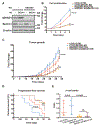Chronic hypoxia stabilizes 3βHSD1 via autophagy suppression
- PMID: 38181788
- PMCID: PMC10851248
- DOI: 10.1016/j.celrep.2023.113575
Chronic hypoxia stabilizes 3βHSD1 via autophagy suppression
Abstract
Progression of prostate cancer depends on androgen receptor, which is usually activated by androgens. Therefore, a mainstay treatment is androgen deprivation therapy. Unfortunately, despite initial treatment response, resistance nearly always develops, and disease progresses to castration-resistant prostate cancer (CRPC), which remains driven by non-gonadal androgens synthesized in prostate cancer tissues. 3β-Hydroxysteroid dehydrogenase/Δ5-->4 isomerase 1 (3βHSD1) catalyzes the rate-limiting step in androgen synthesis. However, how 3βHSD1, especially the "adrenal-permissive" 3βHSD1(367T) that permits tumor synthesis of androgen from dehydroepiandrosterone (DHEA), is regulated at the protein level is not well understood. Here, we investigate how hypoxia regulates 3βHSD1(367T) protein levels. Our results show that, in vitro, hypoxia stabilizes 3βHSD1 protein by suppressing autophagy. Autophagy inhibition promotes 3βHSD1-dependent tumor progression. Hypoxia represses transcription of autophagy-related (ATG) genes by decreasing histone acetylation. Inhibiting deacetylase (HDAC) restores ATG gene transcription under hypoxia. Therefore, HDAC inhibition may be a therapeutic target for hypoxic tumor cells.
Keywords: 3βHSD1; CP: Cancer; CP: Molecular biology; androgen synthesis; autophagy; enzyme; germline; hypoxia; metabolism; prostate cancer; protein; steroid.
Copyright © 2023 The Author(s). Published by Elsevier Inc. All rights reserved.
Conflict of interest statement
Declaration of interests N.S. reports grants from BMS and grants from Astellas outside the submitted work; in addition, N.S. has a patent for HSD3B1 in prostate cancer issued.
Figures






Similar articles
-
Hypoxia-Reoxygenation Couples 3βHSD1 Enzyme and Cofactor Upregulation to Facilitate Androgen Biosynthesis and Hormone Therapy Resistance in Prostate Cancer.Cancer Res. 2022 Jul 5;82(13):2417-2430. doi: 10.1158/0008-5472.CAN-21-4256. Cancer Res. 2022. PMID: 35536859 Free PMC article.
-
Intratumoral androgen biosynthesis associated with 3β-hydroxysteroid dehydrogenase 1 promotes resistance to radiotherapy in prostate cancer.J Clin Invest. 2023 Nov 15;133(22):e165718. doi: 10.1172/JCI165718. J Clin Invest. 2023. PMID: 37966114 Free PMC article.
-
BMX controls 3βHSD1 and sex steroid biosynthesis in cancer.J Clin Invest. 2023 Jan 17;133(2):e163498. doi: 10.1172/JCI163498. J Clin Invest. 2023. PMID: 36647826 Free PMC article.
-
Prospective role of 3βHSD1 in prostate cancer precision medicine.Prostate. 2023 May;83(7):619-627. doi: 10.1002/pros.24504. Epub 2023 Feb 26. Prostate. 2023. PMID: 36842160 Review.
-
HSD3B1, prostate cancer mortality and modifiable outcomes.Nat Rev Urol. 2025 May;22(5):313-320. doi: 10.1038/s41585-024-00953-0. Epub 2024 Nov 14. Nat Rev Urol. 2025. PMID: 39543357 Review.
Cited by
-
Harnessing the tumor microenvironment: targeted cancer therapies through modulation of epithelial-mesenchymal transition.J Hematol Oncol. 2025 Jan 13;18(1):6. doi: 10.1186/s13045-024-01634-6. J Hematol Oncol. 2025. PMID: 39806516 Free PMC article. Review.
-
Acetylation modification in the regulation of macroautophagy.Adv Biotechnol (Singap). 2024 Jun 7;2(2):19. doi: 10.1007/s44307-024-00027-7. Adv Biotechnol (Singap). 2024. PMID: 39883319 Free PMC article. Review.
-
Survival of men with metastatic hormone-sensitive prostate cancer and adrenal-permissive HSD3B1 inheritance.J Clin Invest. 2024 Sep 17;134(18):e183583. doi: 10.1172/JCI183583. J Clin Invest. 2024. PMID: 39286977 Free PMC article.
-
Treatment-induced stemness and lineage plasticity in driving prostate cancer therapy resistance.Cancer Heterog Plast. 2024;1(1):0005. doi: 10.47248/chp2401010005. Epub 2024 Aug 25. Cancer Heterog Plast. 2024. PMID: 39363904 Free PMC article.
-
Transcriptomic Analysis of Metformin's Effect on Bovine Viral Diarrhea Virus Infection.Vet Sci. 2024 Aug 15;11(8):376. doi: 10.3390/vetsci11080376. Vet Sci. 2024. PMID: 39195830 Free PMC article.
References
Publication types
MeSH terms
Substances
Grants and funding
LinkOut - more resources
Full Text Sources
Medical
Miscellaneous

